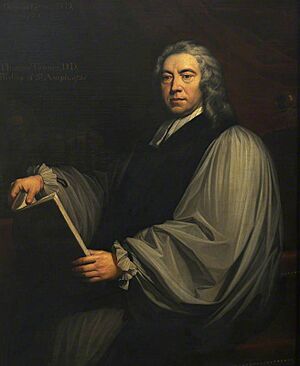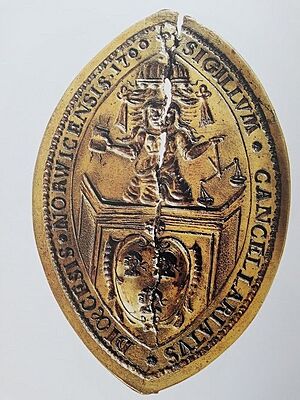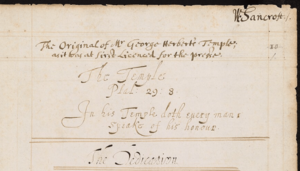Thomas Tanner (bishop) facts for kids
Thomas Tanner (born January 24, 1674 – died December 14, 1735) was an English historian and a church leader. He loved studying old things and was a bishop from 1732 to 1735. Bishops are important leaders in the church.
Contents
Thomas Tanner's Life Story
Thomas Tanner was born in Market Lavington, a town in Wiltshire, England. He went to Oxford University to study. In 1694, he became a priest.
The next year, he worked at All Souls' College in Oxford. He was a chaplain, which is like a personal priest. Later, he became a private chaplain for John Moore. John Moore was a bishop in Norwich and then in Ely. He made Thomas Tanner a "chancellor" for the church area of Norwich. This meant Tanner helped manage church affairs.
Thomas Tanner lived in Norfolk from 1701 to 1731. During this time, he became a rector in Thorpe in 1706. A rector is a priest in charge of a church and its area. In 1713, he became a canon at Ely Cathedral. A canon is a special priest connected to a cathedral. Later, in 1724, he became a canon at Christ Church, Oxford.
On January 23, 1732, Thomas Tanner became the Bishop of St Asaph. This is a very important role in the church. He then spent his time between London, Oxford, and North Wales. He passed away in Oxford when he was 61 years old.
Thomas Tanner's Books and Research
Thomas Tanner wrote several important books during his life. His main book was called Notitia Monastica. This book gave a short history of all the religious houses in England and Wales. These were places like monasteries and convents.
This book was first published in Oxford in 1695. It was later printed again with more information added by his brother, John Tanner, in 1744. It was printed once more in 1787 with even more updates.
He also worked for 40 years on another huge book called Bibliotheca Britannico-Hibernica. This was like a dictionary of all the writers who lived in England, Scotland, and Ireland before the 1600s. He worked on it for a very long time. This book was finished by David Wilkins and published in 1748. This was 13 years after Thomas Tanner had passed away. Tanner also gathered information for a history book about Wiltshire. He also started working on a new version of books by another historian named John Leland.
Thomas Tanner's Collections
When Thomas Tanner moved from Norwich to Oxford, his many books were sent by boat. Sadly, the boat sank at Benson Lock on December 11, 1731. His books were underwater for 20 hours! This caused lasting damage to them.
Thomas Tanner passed away in 1735. He left his amazing collection of historical papers, letters, old handwritten documents (manuscripts), and printed books to the Bodleian Library in Oxford. The Bodleian Library is one of the oldest and most famous libraries in the world.
His collection included about 960 books. These books were from the 1400s to the 1700s. They had examples of early English printing. They also included books about religion and pamphlets from the English Civil War.
Tanner had collected these printed books for his big Bibliotheca project. He got help from John Moore, the Bishop of Norwich, who was also a big book collector. Tanner's handwritten documents came from many different places. He was very interested in collecting letters written by famous people. In 1718, he bought many papers from a historian named John Nalson. Then, in 1724, he bought most of the papers belonging to Archbishop Sancroft. These Sancroft papers made up a large part of Tanner's collection.
Because of the Sancroft papers, Tanner's collection was quickly used by scholars at the Bodleian Library. This happened after the library received the collection in 1736. In 1738, the handwritten documents were organized and sent to be bound into books.
Thomas Tanner also gave a very important collection of old documents called charters and rolls to the Bodleian Library. In 1741, a student named Thomas Toynbee was paid to create a list of all the Tanner manuscripts. The printed books were not listed as quickly. The first time someone asked for a Tanner book was in 1750.
Thomas Tanner's Family
Thomas Tanner was married three times in his life. His first wife was Rose Moore. She was the oldest daughter of Bishop Moore. They got married in 1701. Rose passed away on March 15, 1706, when she was 25 years old. She was buried in Norwich Cathedral. They had a daughter named Dorothy, who died very young.
His second wife was Frances Preston. She passed away on June 11, 1718, at the age of 40. She was buried in the same chapel as his first wife. Thomas Tanner had given the iron gate to this chapel. His family symbols, along with those of his first two wives, are on it. Frances and Thomas had two daughters who died young. They also had a son, also named Thomas Tanner. This son later became a canon in Canterbury and a rector. He married Mary Potter in 1743.
In May 1733, Thomas Tanner married his third wife, Elizabeth Scottowe. She was a wealthy woman. She later married Robert Britiffe, who was a recorder and a Member of Parliament for Norwich. Elizabeth passed away on May 1, 1771, when she was 77 years old.





